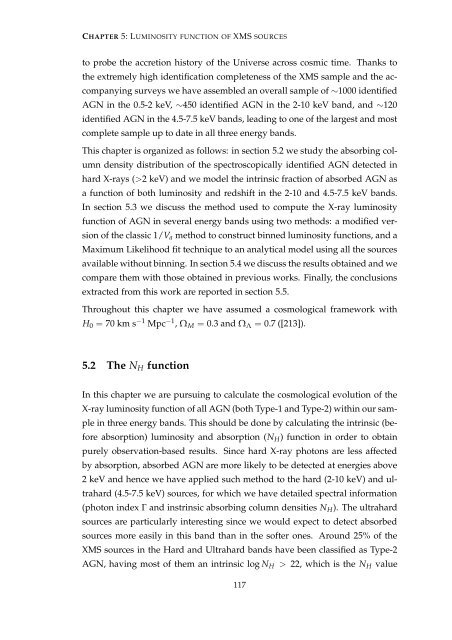pdf - SRON
pdf - SRON
pdf - SRON
Create successful ePaper yourself
Turn your PDF publications into a flip-book with our unique Google optimized e-Paper software.
CHAPTER 5: LUMINOSITY FUNCTION OF XMS SOURCES<br />
to probe the accretion history of the Universe across cosmic time. Thanks to<br />
the extremely high identification completeness of the XMS sample and the accompanying<br />
surveys we have assembled an overall sample of ∼1000 identified<br />
AGN in the 0.5-2 keV, ∼450 identified AGN in the 2-10 keV band, and ∼120<br />
identified AGN in the 4.5-7.5 keV bands, leading to one of the largest and most<br />
complete sample up to date in all three energy bands.<br />
This chapter is organized as follows: in section 5.2 we study the absorbing column<br />
density distribution of the spectroscopically identified AGN detected in<br />
hard X-rays (>2 keV) and we model the intrinsic fraction of absorbed AGN as<br />
a function of both luminosity and redshift in the 2-10 and 4.5-7.5 keV bands.<br />
In section 5.3 we discuss the method used to compute the X-ray luminosity<br />
function of AGN in several energy bands using two methods: a modified version<br />
of the classic 1/V a method to construct binned luminosity functions, and a<br />
Maximum Likelihood fit technique to an analytical model using all the sources<br />
available without binning. In section 5.4 we discuss the results obtained and we<br />
compare them with those obtained in previous works. Finally, the conclusions<br />
extracted from this work are reported in section 5.5.<br />
Throughout this chapter we have assumed a cosmological framework with<br />
H 0 = 70 km s −1 Mpc −1 , Ω M = 0.3 and Ω Λ = 0.7 ([213]).<br />
5.2 The N H function<br />
In this chapter we are pursuing to calculate the cosmological evolution of the<br />
X-ray luminosity function of all AGN (both Type-1 and Type-2) within our sample<br />
in three energy bands. This should be done by calculating the intrinsic (before<br />
absorption) luminosity and absorption (N H ) function in order to obtain<br />
purely observation-based results. Since hard X-ray photons are less affected<br />
by absorption, absorbed AGN are more likely to be detected at energies above<br />
2 keV and hence we have applied such method to the hard (2-10 keV) and ultrahard<br />
(4.5-7.5 keV) sources, for which we have detailed spectral information<br />
(photon index Γ and instrinsic absorbing column densities N H ). The ultrahard<br />
sources are particularly interesting since we would expect to detect absorbed<br />
sources more easily in this band than in the softer ones. Around 25% of the<br />
XMS sources in the Hard and Ultrahard bands have been classified as Type-2<br />
AGN, having most of them an intrinsic log N H > 22, which is the N H value<br />
117
















